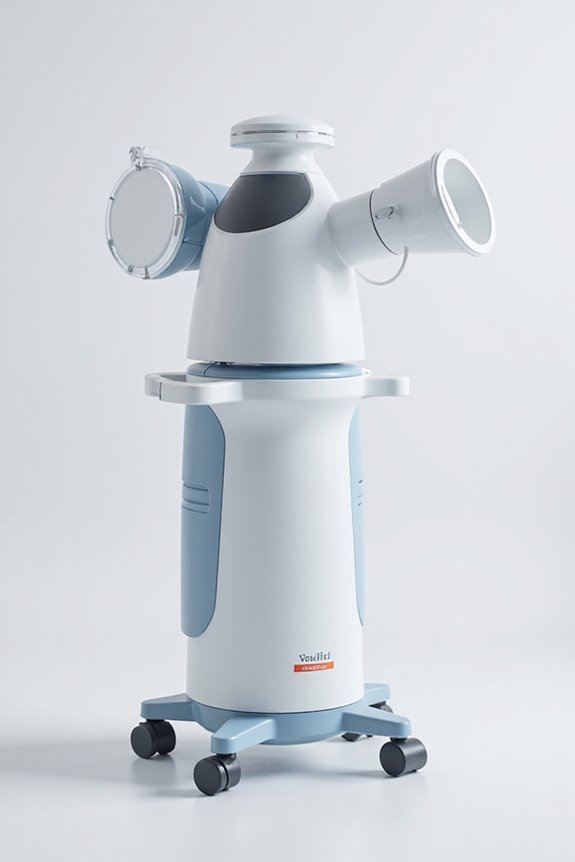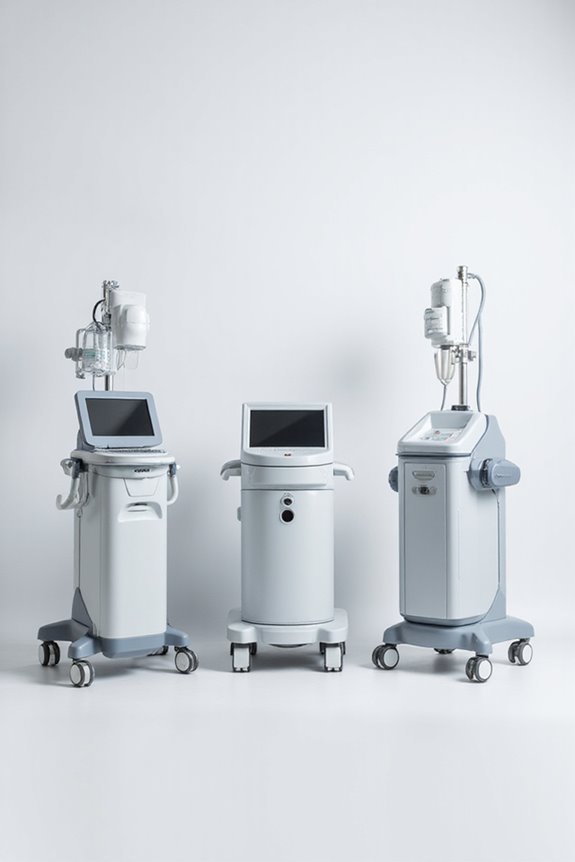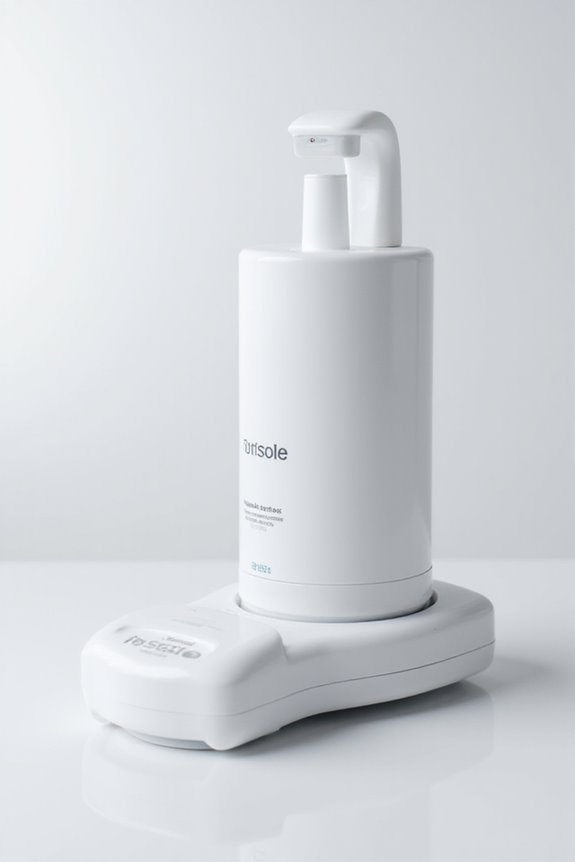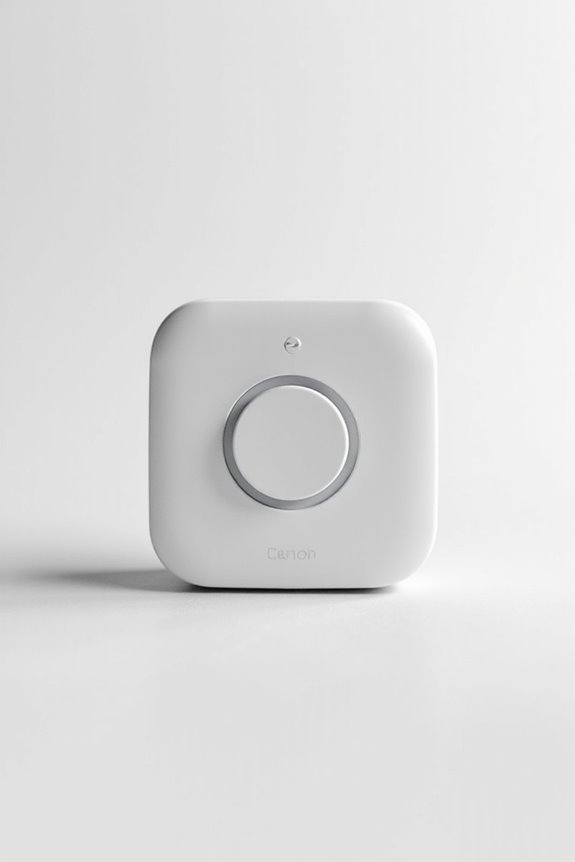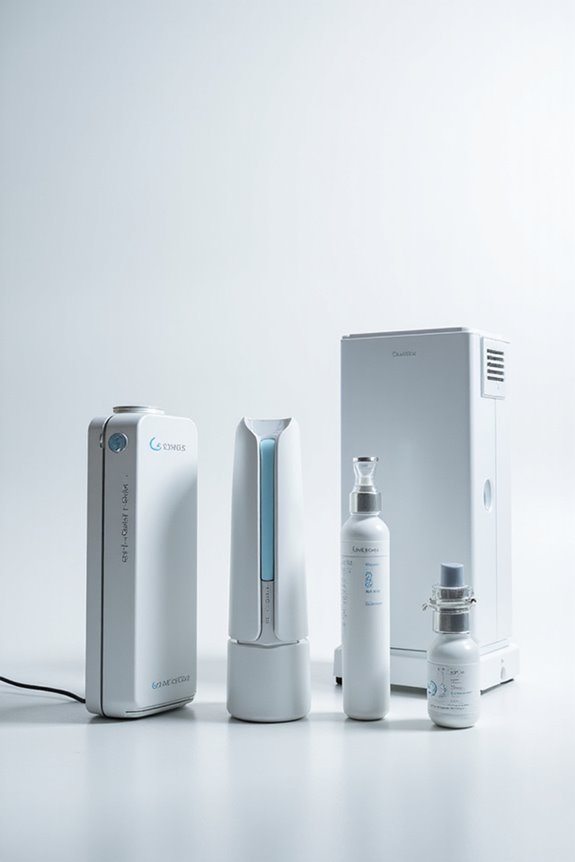In 2025, the top home medical ventilators include:
- Broan ERV100S: 100 CFM airflow, designed for high-rises, with ColdShield™ protection for extreme conditions.
- Radon Mitigation Kit: 260 CFM, DIY installation, reduces radon considerably.
- Drive Medical Med Aire: Provides 4 LPM airflow, employs quiet technology.
- DR.PREPARE Tower Fan: Operates at 25 dB for quiet environments, features customizable speed.
- Drive Medical Variable Pressure Pump: Offers user-customizable settings, fast delivery enhances satisfaction.
Explore further for detailed specifications and evaluations.
Key Takeaways
- Evaluate airflow capacity needs; 100 CFM suits small rooms and 260 CFM works for larger spaces for effective ventilation.
- Consider noise levels; models under 50 dB provide comfort while higher noise can disrupt quiet environments.
- Assess installation requirements for compatibility with your space, ensuring dimensions and ductwork are suitable for each system.
- Check energy efficiency ratings to reduce costly utility expenses, aiming for ENERGY STAR® certified models when possible.
- Look for customizable control options, such as programmable timers and remote controls, for enhanced user convenience and flexibility.
Broan ERV100S 100 CFM Energy Recovery Ventilator with Side Ports – N/A
The Broan ERV100S 100 CFM Energy Recovery Ventilator is an ideal choice for high-rise residential towers or new construction, particularly in southern regions.
Overview
- Model Name: Broan ERV100S
- Airflow Capacity: 100 CFM
- Dimensions: 20D x 9W x 27.125H inches
- Weight: 32 pounds
- Power Source: Electric (120 Volts, 100 watts)
Features
- Design: Ceiling-mounted, minimizes installation footprint
- Noise Level: 73 dB, integrates antivibration system
- ColdShield™ Protection: Tempering fresh air in extreme conditions
Performance
- Efficiency: Sensible efficiency at 32°F: 73; at -13°F: 51
- Filtration Level: 20 PPI
This ventilator provides reliable performance and efficiency for residential spaces, ensuring comfort and maintaining air quality.
Best For: The Broan ERV100S is best for high-rise residential towers or new construction in southern regions that require efficient air ventilation.
Pros:
- Ceiling-mounted design minimizes installation footprint and provides easy maintenance access.
- ColdShield™ protection system effectively tempers fresh air in extreme conditions.
- Integrated antivibration system ensures quieter operation compared to standard ventilators.
Cons:
- Noise level of 73 dB may be noticeable in quiet environments.
- Lacks features such as automatic shutoff, built-in timer, and humidity sensing for enhanced convenience.
- No energy certifications like ENERGY STAR®, potentially affecting energy efficiency perception.
Radon Mitigation System Kit with 260CFM Inline Duct Fan
- Radon Mitigation Installation Kit - 4 to 3 inch radon fans installation kit comes with 2pcs of rubber couplers(4 to 3 inch), 1pc of 4 inch radon fan, 1pc of manometer and...
- Quiet and Energy-saving - 4 inch radon fan adopts built in silent cavity construction which helps create a quieter air movement, providing a more peaceful experience for...
- Strong Plastic Housing, Metal Impeller, Pure Copper Motor - Durable and tough ABS + PC housing with UV protection ingredient added to resist yellowing, fading, or...
For households seeking an effective solution to radon exposure, the Radon Mitigation System Kit with a 260 CFM Inline Duct Fan serves as an ideal choice.
Product Features
- Airflow Capacity: 260 CFM
- Fan Speed: 2600 RPM
- Noise Level: Under 50 dB
- Wattage: 85 Watts
- Voltage: 110 Volts
- Dimensions: 12.2D x 11.2W x 13.1H inches
Key Components
- 2 Rubber Couplers
- 1 Radon Fan (4 inch)
- 1 Manometer
- User Manual
Performance
- Durability: ABS + PC housing, metal impeller
- Waterproof Rating: IP67
This kit is effective in reducing radon levels considerably, making it suitable for various environments, including basements and garages.
Best For: Households and businesses looking for a cost-effective and efficient solution to reduce radon levels.
Pros:
- Effective Radon Reduction: Capable of lowering radon levels significantly, from 6+ to under 1.0.
- DIY Installation: User-friendly kit allows for easy installation without professional help, saving on service costs.
- Durable and Reliable: Features a long service life with robust materials and waterproof rating suitable for various environments.
Cons:
- Limited Airflow Capacity: The 260 CFM may not be sufficient for larger spaces or severe radon issues.
- Noise Level: Although relatively quiet, some users may still find the under 50 dB noise level noticeable in quiet environments.
- Dependence on Proper Installation: Effectiveness heavily relies on correct installation and placement, which may be a barrier for some users.
Drive Medical Med Aire Fixed Pressure Pump System, White
- 4 LPM (Liters per Minute) pump produces consistent air flow and pressure over a 5 minute cycle time
- Quiet pump technology alternately inflates and deflates the air cells
- Fixed Pressure
Drive Medical Med Aire Fixed Pressure Pump System serves as an ideal choice for individuals requiring consistent airflow for air mattresses in home medical settings.
Specifications:
- Produces 4 liters per minute (LPM) of continuous airflow
- Operates on a fixed pressure with a 5-minute cycle time
- Employs quiet pump technology for alternating inflation and deflation
Performance:
- Generally provides reliable airflow and pressure
- Best suited for air mattresses, but not recommended for nebulizers
User Experiences:
- Positive feedback includes effectiveness; however, some report issues
- Complaints about non-returnable items and customer support difficulties
Consider these factors thoroughly before purchasing.
Best For: Individuals requiring consistent airflow for air mattresses in home medical settings.
Pros:
- Provides a consistent airflow of 4 LPM and operates quietly.
- Generally effective for maintaining air pressure in air mattresses.
- Positive user feedback regarding its functionality and effectiveness.
Cons:
- Reports of malfunction and durability issues after short usage periods.
- Non-returnable policy and challenges obtaining replacements or support.
- Mixed reviews suggest caution due to variable customer experiences.
DR.PREPARE Quiet DC Bladeless Tower Fan with Remote
- [12W Powerful DC Motor] Efficient DC motor delivers powerful cool winds to your living space. Up to 2000 RPM and 23 ft/s wind speed will cool you off instantly. Get your...
- [Near Silent Cooling] Engineered for ultra-quiet cooling and high wind speeds. As low as 25 dB, this tower fan brings maximum comfort for your sound sleep, without...
- [Convenient Touchscreen & Remote Control] The upper control panel and smart remote controller make this table fan easy to use. You can set wind speeds, auto-off hours,...
Elevate your indoor air experience with the DR.PREPARE Quiet DC Bladeless Tower Fan, an ideal solution for professionals and individuals seeking effective cooling in home environments.
Key Features
- Noise Level: Operates as low as 25 dB
- Speed Settings: 8 customizable speeds
- Oscillation: 80° oscillation for even distribution
Performance Specifications
- Power: Corded electric, 12W
- Dimensions: 6.2D x 6.2W x 16H inches
- Weight: 3.3 pounds
User Experience
- Controls: Remote and touchscreen operation
- Timer: 1-8 hours programmable
Best For: Individuals seeking a quiet, efficient cooling solution for small spaces like bedrooms and home offices.
Pros:
- Quiet Operation: Runs at a noise level as low as 25 dB, perfect for uninterrupted sleep or work.
- Customizable Airflow: With 8 speed settings, users can tailor the airflow to their comfort preferences.
- Convenient Timer and Remote Control: Programmable timer and remote control enhance ease of use and flexibility.
Cons:
- Remote Control Range: Users have reported a limited range on the remote control, requiring direct line of sight.
- Lack of Storage for Remote: There is no designated storage for the remote, making it easy to misplace.
- No Tilting Feature: The fan lacks a tilting option, which restricts airflow direction adjustment.
Drive Medical Med Aire Variable Pressure Pump, White, Universal
- 4 LPM (Liters per Minute) pump produces consistent air flow and pressure over a 5 minute cycle time
- Quiet pump technology alternately inflates and deflates the air cells
- Variable pressure setting on allows comfort setting for maximum comfort and compliance
Delivering consistent air flow and pressure, the Drive Medical Med Aire Variable Pressure Pump is an essential component for patients requiring bariatric care or those at risk of pressure sores.
- Performance: This 4 LPM pump guarantees steady airflow over a 5-minute cycle, utilizing quiet pump technology to alternately inflate and deflate air cells.
- Adjustability: The variable pressure setting allows for user customization, optimizing comfort during use.
- Included Components: The package contains the pump, power cord, hoses, and a bladder; however, the bed mat must be purchased separately.
Customer satisfaction varies, with some noting effectiveness and others reporting missing components or unmet expectations.
Best For: Patients requiring bariatric care or those at risk of pressure sores who benefit from variable pressure adjustments for enhanced comfort.
Pros:
- Quiet operation minimizes disturbances during use, promoting a restful environment.
- Customizable pressure settings allow users to adjust comfort levels according to individual needs.
- Fast delivery service ensures that the product reaches users promptly, enhancing overall satisfaction.
Cons:
- Some users reported missing components, which can hinder the product’s effectiveness.
- There is confusion regarding product contents, leading to dissatisfaction among some customers.
- Mixed customer feedback suggests variability in effectiveness, particularly concerning pressure sore relief.
Factors to Consider When Choosing a Home Medical Ventilator
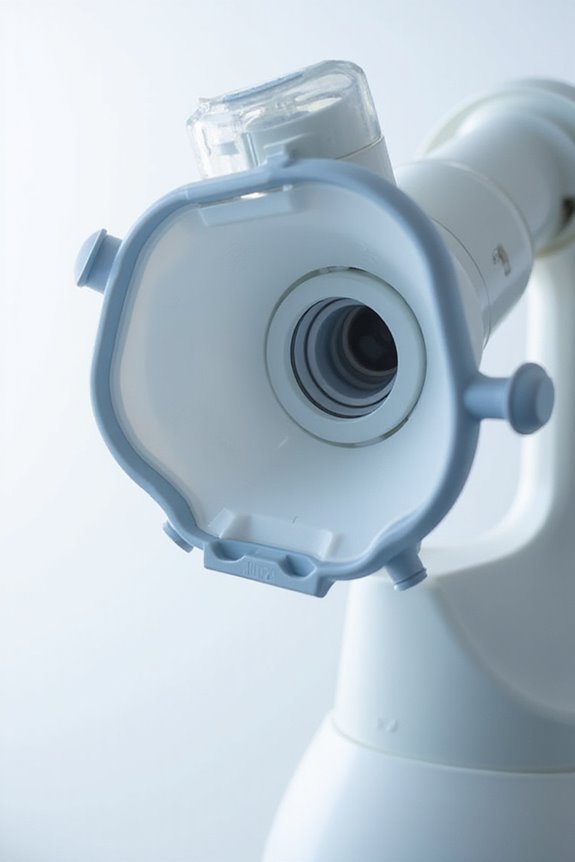
When choosing a home medical ventilator, consider several critical factors to guarantee it meets your needs. Evaluate the airflow capacity, noise level, and installation requirements, as these directly impact functionality and comfort. Additionally, review energy efficiency ratings and control functionality options to optimize performance and ease of use.
Airflow Capacity Considerations
Airflow capacity is a fundamental consideration when choosing a home medical ventilator, as it directly impacts the unit’s efficacy in providing adequate ventilation.
- Capacity Measurement: Airflow capacity is measured in cubic feet per minute (CFM).
- Room Size Suitability: A unit with 100 CFM is adequate for smaller rooms, while 260 CFM is better for larger spaces or significant air exchange needs.
- Health Risks: Insufficient airflow can lead to inadequate ventilation, posing potential health risks.
- Design Factors: The design and placement of ports influence how efficiently airflow is distributed.
Determining the specific airflow requirements of your environment is essential for maximizing ventilation effectiveness and safety.
Noise Level Assessment
- Devices operating under 50 dB minimize disruption, enhancing comfort, especially at night.
- Many ventilators can reach up to 73 dB, greatly affecting your environment.
- Features like quiet pump technology aim to maintain relief while keeping noise levels manageable.
- Customer feedback frequently emphasizes a preference for ventilators that balance effective airflow with minimal sound disruption.
- Consider adjustable settings to accommodate your sensitivity to sound, as different locations and times of day require varying noise levels.
Choose wisely to guarantee both comfort and functionality align with your lifestyle.
Installation Requirements Evaluation
Evaluating installation requirements is essential to confirm your home medical ventilator functions effectively. Here are key factors to assess:
- Space Assessment: Measure the intended area to affirm it can accommodate the ventilator’s dimensions, like the Broan ERV100S, which is 20D x 9W x 27.125H inches.
- Environment Suitability: Verify that the model is appropriate for your installation setting, such as high-rise buildings or unheated spaces.
- Maintenance Access: Choose systems with a minimized footprint for easier upkeep.
- Electrical Compliance: Confirm the unit’s voltage and wattage fit your home’s supply, like the Broan ERV100S requiring 120 volts and consuming 100 watts.
- Ductwork Compatibility: Check if current ducting can support airflow needs, as some models may require airflow capacities of 100 CFM.
Energy Efficiency Ratings
Energy efficiency ratings play a critical role when selecting a home medical ventilator, impacting both performance and operational costs. Here are key factors to take into account:
- Energy Consumption: Higher efficiency models typically consume less power over time, reducing your overall expenses.
- Sensible Efficiency Ratings: Look for units that effectively manage temperature and humidity, especially in extreme conditions.
- Sensible Recovery Efficiency: Measured at various temperatures, this rating indicates how well a ventilator recovers heat from outgoing air. Higher percentages signify better performance.
- Noise Levels: Lower decibel levels (under 50 dB) guarantee comfort in residential settings.
- Certifications: Check for products with ENERGY STAR® or similar certifications, as they reflect adherence to rigorous efficiency standards.
Control Functionality Options
How can you guarantee peak functionality in a home medical ventilator?
When evaluating control functionality options, consider the following:
- Touch Control Methods: Look for ventilators with easy adjustment interfaces to modify airflow settings seamlessly.
- Programmable Timers: Features that allow you to set specific operating hours enhance convenience and save energy.
- Remote Control Capabilities: Advanced models may offer remote access to adjust settings from a distance.
- User-Friendly Interfaces: Clear displays of airflow rates and operational statuses facilitate proper monitoring.
- Customizable Pressure Settings: Certain ventilators let you tailor pressure settings to your comfort needs, assuring a personalized experience.
Selecting a ventilator with these options enhances usability and guarantees peak performance tailored to individual requirements.
Warranty and Support Services
When selecting a home medical ventilator, warranty and support services are paramount factors that can greatly impact your experience.
Warranty Coverage
- Look for extensive warranties covering both parts and labor, which can minimize unexpected repair costs.
- Duration and terms may vary by manufacturer, so review details carefully.
Support Services
- Guarantee responsive customer service with clear communication channels, aiding in installation, troubleshooting, and maintenance.
- Check for the availability of replacement parts and accessories to enhance the ventilator’s longevity.
User Reviews
– Analyze user feedback regarding warranty and support, as this can highlight common issues or effective solutions shared by others.
These factors will ultimately influence both the functionality and reliability of your chosen ventilator.
Frequently Asked Questions
How Do I Know if I Need a Home Medical Ventilator?
To determine if you need a home medical ventilator, consider these symptoms:
- Chronic respiratory issues
- Frequent hospitalizations due to breathing difficulties
- Reduced oxygen levels, as seen in blood tests
Consult a healthcare professional for an accurate diagnosis. They may assess your lung function and propose a treatment plan, including ventilatory support. If you find yourself struggling to breathe or maintaining adequate oxygen levels, seeking medical advice promptly is essential.
What Is the Typical Lifespan of a Home Medical Ventilator?
The typical lifespan of a home medical ventilator varies. Key factors include:
- Usage: Daily use may reduce lifespan.
- Maintenance: Regular servicing can extend functionality.
- Model: Newer models tend to be more durable.
Generally, you can expect a home ventilator to last between 5 to 10 years. Factors such as technological advancements may influence longevity. Always consult manufacturers for specific guidelines regarding the model you use for accurate expectations.
Can I Travel With My Home Medical Ventilator?
Traveling with your home medical ventilator can feel like packing a lifeline. To do so safely, consider the following:
- Check airline regulations: Different carriers have specific policies regarding medical devices.
- Battery life: Verify your ventilator’s batteries are fully charged and bring extras.
- Required documentation: Obtain a doctor’s note indicating your need for the ventilator.
- Carry-on requirements: Keep the ventilator with you during transit when possible for added safety.
Planning ahead is key.
How Often Should I Replace Ventilator Accessories and Filters?
To maintain ideal function, you should replace ventilator accessories and filters regularly:
- Filters: Replace every 1-3 months. Monitor for discoloration or damage.
- Tubing: Replace every 6 months or as needed if damaged.
- Masks: Replace every 3-6 months, or sooner if wear is evident.
Regular replacements guarantee effective ventilation, reduce infection risk, and prolong the lifespan of your equipment. Always consult your manufacturer’s guidelines for specific recommendations.
Are Insurance Plans Likely to Cover Home Medical Ventilators?
When considering home medical ventilators, think of insurance as a roadmap. Coverage can vary greatly.
- Insurance Plans: Most plans may cover medically necessary equipment.
- Prior Authorization: Your provider often requires pre-approval.
- Documentation: A detailed prescription and medical records strengthen your case.
Research your specific policy, as coverage may depend on diagnosis, provider, and state regulations. Contact your insurer for clarity on benefits and limitations.

